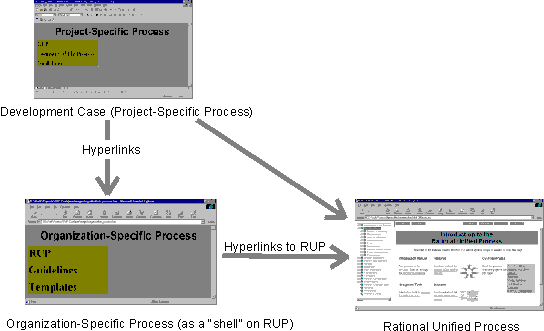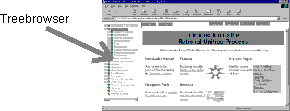Concepts: Process Configuration
Topics
Introduction 
In general, there are two levels at which the software-engineering process can be adapted or modified:
- An organization-wide process where process engineers modify, improve or tailor a common process to be used organization-wide. This takes into consideration issues such as the application domain, reuse practices, and core technologies mastered by the company. One organization can have more than one organization-wide process, each adapted to a different type of development. In many cases, the Rational Unified Process serves as the organization-wide process.
- A project-specific process where process engineers take the organization-wide process and further refine it for a given project. This level takes into consideration the size of the project, the reuse of company assets, the initial cycle ("green-field development") versus the evolution cycle, and so on. The project-specific process is what is described in the Rational Unified Process as a Development Case.
Whether or not you should modify the Rational Unified Process is discussed in detail in the section Optionally: Modify the Rational Unified Process.
Organization-Wide Process 
Configuring, or customizing, the Rational Unified Process for the organization means that you develop your own organization-wide process product using the Rational Unified Process as the baseline. This means that you:
- Develop reusable development cases
- Develop reusable templates
- Develop reusable guidelines
- Build a "shell" that contains the organization-wide process product
Develop Reusable Development Cases (to Organization-Wide Process)
Develop reusable development cases that the projects can use as a starting point when developing the project's development case. There can be more than one reusable development case. For example, there can be one reusable development case per type of development.
A reusable development case is a development case with a number of decisions, or suggestions, already made.
Develop Reusable Templates (to Organization-Wide Process)
The templates provided with the Rational Unified Process are ready-to-use. However, many organizations have their own standards for the layout of documents and reports. In that case, you'll need to change the layout of the templates and the logotype. The following pages describe how to customize the Microsoft« WordÖ templates and the Adobe« FrameMakerÖ templates:
- Installing and Customizing Word Templates
- Instructions for Using the Rational Unified Process (RUP) FrameMaker Templates
Develop Reusable Guidelines (to Organization-Wide Process)
Develop guidelines for the Environment Artifact Set to be reused by the software-development projects, including:
- Business Modeling Guidelines
- Design Guidelines
- Manual Styleguide
- Programming Guidelines
- Test Guidelines
- Use-Case Modeling Guidelines
- User-Interface Guidelines
Several of these guidelines contain information that can be used by many projects. Programming Guidelines and Manual Styleguide are often so general that once you have them, they can be reused by most projects.
A good strategy is to develop these guideline artifacts within the scope of one project. Decide after that project whether to reuse the guideline or whether it needs to be modified. The guidelines can be reused by removing project-specific information.
Build a Shell to Organization-Wide Process
You can build an organization-wide process product as a "shell" on top of the Rational Unified Process. Build it as a web site and have hyperlinks to the Rational Unified Process. See Developer's Kit. The size of the organization-wide process can range from a few Web pages to a fully-featured Web site with a search engine, index, and navigation tools, such as a treebrowser.

An organization-specific process
You can choose to use the same tools and techniques to develop the organization-wide process, that were used to develop the Rational Unified Process. Make sure the "shell" clearly specifies what parts of the Rational Unified Process the organization will, and won't, use.
For example, an organization-wide process can contain:
- Development cases, more or less ready-to-use for the projects
- Templates tailored to the organization
- Examples specific to the organization
- Guidelines that can be used as-is, without modifications; for example, Programming Guidelines
- Other process material; for example, if you have a process for testing that you want to keep, add hyperlinks from the organization-wide process
An organization can have more than one organization-wide process. For example, if your organization develops software for different application domains, you could have one organization-wide process for each application domain.
Project-Specific Process 
We recommend that every project configures the process, which means that you:
Develop a Development Case to Project-Specific Process
Develop a Development Case that describes the project's process. The development case references the Rational Unified Process for details. Notice that a development case can be very lean and does not have to cover all workflows. See Activity: Develop Development Case for more information.
We recommend that the front-end of the Development Case is developed as a minimal set of Web pages, and that details provided in the Rational Unified Process, or in a similar knowledge base, are accessed by reference using hyperlinks.

A Development Case with hyperlinks to the online Rational Unified Process.
Customize Templates to Project-Specific Process
Customize the document templates and report templates the project will use. The Microsoft Word and FrameMaker templates are designed for the addition of your company name and logotype. We also expect projects will customize the templates to their specific needs by adding or removing sections. See Activity: Develop Project-Specific Templates and Artifact: Project-Specific Templates for details.
Develop Supporting Guidelines to Project-Specific Process
Decide which of these guidelines from the Environment Artifact Set should be developed to support the project-specific process, then develop them:
- Business Modeling Guidelines
- Design Guidelines
- Manual Styleguide
- Programming Guidelines
- Test Guidelines
- Use-Case Modeling Guidelines
- User-Interface Guidelines
These guidelines help the project members to get a quick-start and help enforce a common way to describe artifacts. Notice that these guidelines do not have to be completely described documents. A cost-effective method is to develop sample artifacts that can serve as examples of how artifacts should look. For example, a sample use case may serve as the Use-Case Modeling Guidelines. The Rational Unified Process comes with ready-to-use examples of Programming Guidelines for C++, Ada, and Java.
Use the Organization-Wide Process to Project-Specific Process
Each project develops a development case that will have hyperlinks to the Rational Unified Process and the organization-wide process.

The Development Case with hyperlinks
Optional: Modify
the Rational Unified Process 
In some situations you may want to modify the Rational Unified Process itself.
Modifications that are easy to maintain. You can customize the Rational Unified Process by modifying the treebrowser in the left frame, and adding references to external papers, your own guidelines, your own templates, and so on. Modifications of this type are easy to do and make upgrades simple to perform when new versions of the Rational Unified Process are released.

You can customize the treebrowser in the Rational Unified Process online
You can further integrate your own pages into the Rational Unified Process by making your pages:
- Referenced from the index by generating a new index
- Searchable using the search functionality by generating a new search database
- Listed on the Overview Table by generating a new Overview Table
To integrate your pages in the index, search database, and overview table place your own pages in a folder inside the folder where the Rational Unified Process is installed, that is, the folder where the index.htm resides. The Tool Mentor: Using the RUP Tools describes how to generate a new index, new search database, and new overview table. The "KeyWordIndex" describes how to insert keywords for the index. To understand and modify the layout of the overview table, see the SiteMap.
Another way to modify the Rational Unified Process is to edit its layout and format to conform to your company's style and formats. For example, you can change the color on the banners or change the buttons, bullets, and so on. These kinds of changes are simple to do and make it easy to upgrade to new versions. See Guidelines: RUP Style for more information about how to change the layout.
Modifications that are more difficult to maintain. A more advanced way to modify the Rational Unified Process is to edit pages, diagrams, and so on to describe exactly how your organization works. However, this has several disadvantagesùit makes it more difficult to upgrade and it's no longer obvious to users which parts have been customized. At times, you may want to emphasize those parts of the process that you've chosen to customize, as opposed to those parts that you haven't. If you do these kinds of changes, you should put a baseline copy of the Rational Unified Process online under configuration management. Process engineers can modify it to incorporate changes, such as:
- Add, expand, modify or remove steps in activities.
- Add checkpoints to the review activities based on experience, especially for problems discovered late in the development cycle.
- Add guidelines based on discoveries made in past projects.
- Tailor the templates by adding your company logo and specific header, and footer, information throughout the document for easy identification, and by customizing the cover page to make it specific to your organization.
- Add tool mentors as needed.
Some changes are harder to make than others, such as:
- Changing process terminology because it would have sweeping effects.
- Using another process model.
- Changing the core workflow structure.
Note that these kinds of changes will affect the corresponding Development Case, and will make the reconciliation with future releases of the Rational Unified Process more difficult.